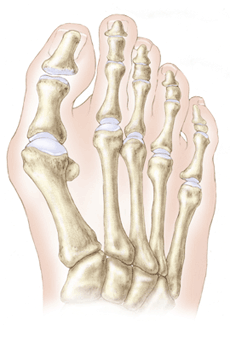





 A
bunion (hallux valgus deformity) is a bony bump on the
outside and top of the great toe, where it connects to the foot. Half
of those who have the problem will have bunions on both feet. Only
a small number of people develop a bunion in childhood, and there
is some evidence that, in these cases, heredity may play a role. Women
develop bunions ten times more often than men, and they are usually
in their 40s or 50s when the deformity becomes a problem. This
may be because, over the years, they have worn shoes that are too
narrow, causing pressure on the great toe. Over time, the pressure
from shoes with pointed toes and high heels can deform the great toe,
and encourages the bony growth that eventually becomes a bunion. A
bunion (hallux valgus deformity) is a bony bump on the
outside and top of the great toe, where it connects to the foot. Half
of those who have the problem will have bunions on both feet. Only
a small number of people develop a bunion in childhood, and there
is some evidence that, in these cases, heredity may play a role. Women
develop bunions ten times more often than men, and they are usually
in their 40s or 50s when the deformity becomes a problem. This
may be because, over the years, they have worn shoes that are too
narrow, causing pressure on the great toe. Over time, the pressure
from shoes with pointed toes and high heels can deform the great toe,
and encourages the bony growth that eventually becomes a bunion. The function of the great toe is very important to normal gait. The great toe is stabilized on both sides by ligaments, and when a step is taken, the stability of the arch is maintained through the great toe's movement. When the foot moves through a step, the great toe extends, causing the arch to rise, and stabilizing the arch at the same time. This is called the windlass mechanism. Patients with moderate to severe bunion deformities may have an abnormal gait because the bunion has compromised this mechanism. There are all types of bunion deformities, ranging from mild to quite severe. Larger bunions are generally more painful. Some people can develop pain in the second toe as well, due to instability caused by pressure from the deformed great toe. |